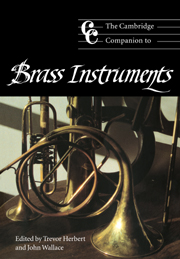Book contents
- Frontmatter
- Introduction
- 1 Lip-vibrated instruments of the ancient and non-western world
- 2 How brass instruments work
- 3 Design, technology and manufacture before 1800
- 4 Brass instruments in art music in the Middle Ages
- 5 The cornett
- 6 ‘Sackbut’: the early trombone
- 7 The trumpet before 1800
- 8 The horn in the Baroque and Classical periods
- 9 Design, technology and manufacture since 1800
- 10 Keyed brass
- 11 The low brass
- 12 Brass in the modern orchestra
- 13 Brass bands and other vernacular brass traditions
- 14 Playing, learning and teaching brass
- 15 The post-classical horn
- 16 Jazz, improvisation and brass
- 17 Brass solo and chamber music from 1800
- 18 Frontiers or byways? Brass instruments in avant-garde music
- Glossary
- Notes
- Select bibliography
- Index
18 - Frontiers or byways? Brass instruments in avant-garde music
Published online by Cambridge University Press: 28 September 2011
- Frontmatter
- Introduction
- 1 Lip-vibrated instruments of the ancient and non-western world
- 2 How brass instruments work
- 3 Design, technology and manufacture before 1800
- 4 Brass instruments in art music in the Middle Ages
- 5 The cornett
- 6 ‘Sackbut’: the early trombone
- 7 The trumpet before 1800
- 8 The horn in the Baroque and Classical periods
- 9 Design, technology and manufacture since 1800
- 10 Keyed brass
- 11 The low brass
- 12 Brass in the modern orchestra
- 13 Brass bands and other vernacular brass traditions
- 14 Playing, learning and teaching brass
- 15 The post-classical horn
- 16 Jazz, improvisation and brass
- 17 Brass solo and chamber music from 1800
- 18 Frontiers or byways? Brass instruments in avant-garde music
- Glossary
- Notes
- Select bibliography
- Index
Summary
The stage is empty, except for a low stand and a chair. Enter a trombone player, immaculate in white tie. He points his instrument in the air and plays a single loud, high note. He repeats the action, at six-second intervals. At the fifth attempt, no sound comes. Rattled, he becomes more energetic. He has a tin basin, which he holds over the bell of his instrument: occasionally, he sings a pert ‘wa’ and the trombone, the basin acting as lips, mimics him. The notes come faster. The player is frantic, then hysterical, but the harder he works the less sound he makes. Paralysis ensues. The trombonist utters a bewildered ‘WHY?’ and crumples onto the chair. From this position he plays a complex, tormented lament. The sound is continuous; even when inhaling he groans and rattles his basin. The instrument enunciates syllables, sounds are distorted, losing any sense of defined pitch, and, more often than not, the trombonist wails and plays at the same time. The borders between instrument and player, voice and blown sound, speech and the tin lips of the basin, become blurred, and as the last note dies away it is difficult to tell if it is played or sung.
This is not the work of a fringe eccentric: Sequenza V by Luciano Berio (Ex. 11) has an enduring place in the repertoire. Nor is it an improvisation. Its notation is precise: the position of the mute is indicated by a separate stave, the pitches of the sung and played notes are for the most part clearly given, and even the angle of the instrument is shown with arrows and lines. Though the rhythms are indicated by proportion rather than mensuration it is a work as clearly conceived as a Beethoven quartet.
- Type
- Chapter
- Information
- The Cambridge Companion to Brass Instruments , pp. 255 - 272Publisher: Cambridge University PressPrint publication year: 1997



